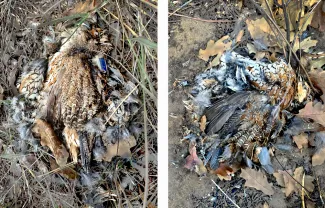
Provided by Oklahoma Cooperative Fish and Wildlife Research Unit, Oklahoma State University
Two trapping technicians continued trapping quail through November, one at Packsaddle Wildlife Management Area and the other at Beaver River WMA for the first half of the month. Both technicians trapped quail and were able to deploy transmitters. In total, 17 transmitters were deployed during November, with seven being deployed at Beaver River and 10 at Packsaddle.
The team recovered seven downed transmitters during November, four from Beaver River and three from Packsaddle. No clear mortality signs could be identified for one of the recovered transmitters, while two showed signs of mammalian predation, one of avian predation, one of an unknown predator, and two attributed to the ice storm at the end of October (see photo).
At least two of the quail with transmitters that continued to transmit data after the ice storm appear to have been killed in that severe weather event. If susceptibility to weather-related mortality is similar for quail with and without transmitters, the October storm likely caused widespread quail mortality in areas of western Oklahoma most impacted by the severe winter storm, perhaps as high as 33 percent in hard-hit areas. All mortalities attributed to the ice storm were based on location data indicating that the transmitters became stationary during or immediately after the storm and that the carcasses did not show any sign of predation (though two showed signs of scavenging by smaller animals).
During November, a total of 31 GPS transmitters were active across two of the four WMAs, with 14 deployed at Beaver River and 17 at Packsaddle. There were no active transmitters at Cross Timbers or Sandy Sanders WMAs during November. All transmitters were of the type with satellite download.
In total, the project has now collected 64,190 individual locations since the launch of the first transmitter in May 2018. The 12 wildlife cameras positioned on the research plots at each of the four WMAs continue to record wildlife use at each treatment plot. Analyses of bird survey data and vegetation data, as well as movement data from the GPS transmitters, continued during November.
- In the area of invertebrate work, Jacob Reeves defended his Master’s thesis titled “Availability and Nutrient Content of Common Arthropod Prey of Northern Bobwhites (Colinus virginianus) in Western Oklahoma” and worked on revising each chapter before submission to peer-reviewed journals.
National Report Features Oklahoma Telemetry Project

The National Bobwhite Conservation Initiative (NBCI) has featured the Research Unit’s quail ecology and management project in its Bobwhite Almanac: State of the Bobwhite 2020 report. The article headlined “Massive Bobwhite Telemetry Project Underway in Oklahoma” by NBCI Communications Director Joh Doty explains how new-technology GPS transmitters are being used to track the movement of northern bobwhites on four Wildlife Department wildlife management areas.
The National Bobwhite Conservation Initiative is the unified strategic effort of 25 state fish and wildlife agencies and various conservation organizations — all under the umbrella of the National Bobwhite Technical Committee — to restore wild populations of bobwhite quail in this country to levels comparable to those of 1980. The Oklahoma Department of Wildlife Conservation is a member of NBCI, the most comprehensive interstate effort on behalf of a resident game bird in the history of wildlife management.
To download the 2020 report from NBCI’s website, go to https://bringbackbobwhites.org/download/nbcis-bobwhite-almanac-state-of-the-bobwhite-2020/. To watch a TV episode of “Outdoor Oklahoma” featuring the Oklahoma quail telemetry project, go to https://www.youtube.com/watch?v=A0ssDRFrGgg&feature=youtu.be.
(This project is funded in part by the Oklahoma Department of Wildlife Conservation's State Wildlife Grants Program, Federal Aid Project F18AF001-10.)